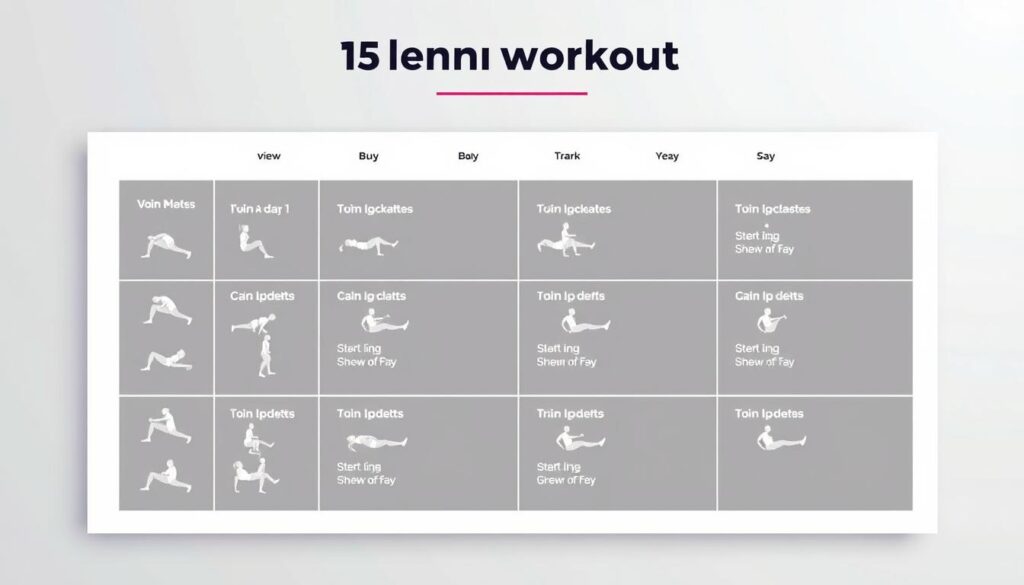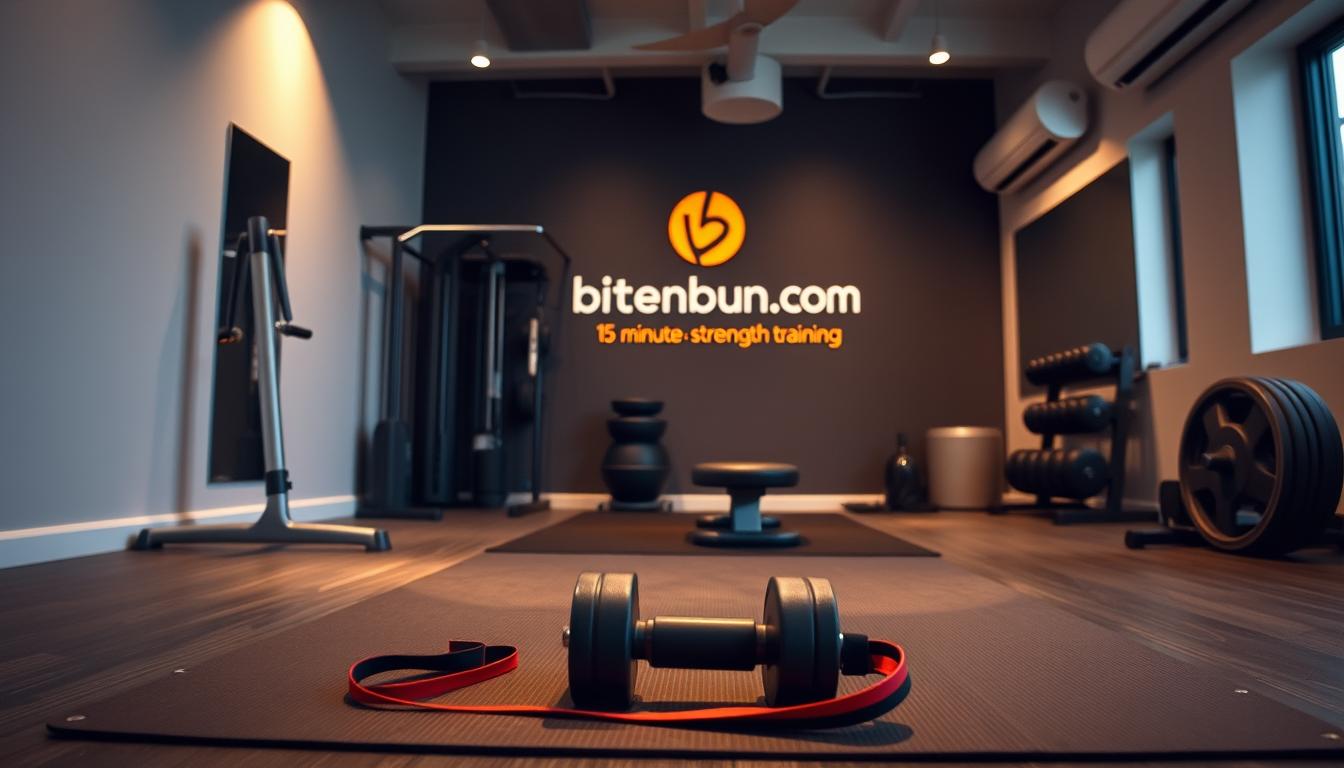A 15-minute daily workout can be a game-changer for those with hectic lifestyles. Research has shown that just a short period of moderate exercise each day can significantly impact overall health and longevity.
In a large 2011 study, 15 minutes of moderate exercise daily was linked to longer life expectancy and reduced risk of mortality. We can all spare 15 minutes a day to invest in our health. Our busy lives often make it challenging to fit in a workout, but with the right approach, it’s possible to achieve significant results in just a few minutes a day.
Key Takeaways
- Short, intense workouts can be as effective as longer sessions.
- Consistency is key to achieving fitness goals, even with busy schedules.
- Minimal equipment is required for effective strength training at home or on the go.
- Workouts can be tailored to suit different fitness levels and goals.
- Even a short period of exercise daily can have significant health benefits.
The Science Behind Quick 15-Minutes Strength Training for Busy Schedules
Busy schedules demand efficient workouts, and recent studies have shown that short, intense strength training sessions can be remarkably effective. The key to their success lies in the scientific principles that govern how our bodies respond to exercise.
Why Short Workouts Can Be Effective
Short workouts can be effective due to the concept of muscle fiber recruitment. When we engage in brief, intense training, we activate our fast-twitch muscle fibers, which are responsible for strength and power. This type of training stimulates significant muscle growth and strength gains.
As Dr. Izumi Tabata’s research on Tabata intervals demonstrates, short cycles of intense exercise followed by brief rest periods can lead to substantial improvements in both aerobic and anaerobic capacity. This is because such training enhances explosive energy, allowing for more reps with a given weight or more weight for a given number of reps.
| Training Method | Aerobic Capacity Improvement | Anaerobic Capacity Improvement |
|---|---|---|
| Tabata Intervals | Significant | Significant |
| Traditional Steady-State | Moderate | Minimal |
The Physiological Benefits of Brief, Intense Training
Brief, intense training offers several physiological benefits, including increased muscle growth and enhanced metabolic improvements. The hormonal response to such training includes the release of growth hormone and testosterone, which supports muscle development.
Moreover, short, intense workouts can be less taxing on the central nervous system than longer sessions, allowing for quicker recovery and more frequent training. As a result, individuals can achieve significant strength gains and improvements in body composition.
Essential Equipment for Time-Efficient Workouts

Effective strength training doesn’t require a lot of equipment or a gym membership. With the right approach, you can achieve a great workout in minimal time, using either your own body weight or minimal equipment.
Bodyweight Training Options
Bodyweight exercises are a great way to work out without any equipment. They offer convenience, versatility, and effectiveness for building functional strength. You can do push-ups, squats, lunges, and planks anywhere, making them ideal for busy individuals. For example, a simple bodyweight circuit could include 10-15 reps of each exercise, done in succession with minimal rest in between.
Minimal Equipment Recommendations
If you prefer to use some equipment, consider options like resistance bands, dumbbells, or kettlebells. These provide maximum versatility and can be used for a variety of exercises. For instance, a single pair of dumbbells can be used for exercises like bicep curls, shoulder presses, and squats. Here’s a comparison of minimal equipment options:
| Equipment | Cost | Versatility |
|---|---|---|
| Resistance Bands | Low | High |
| Dumbbells | Moderate | High |
| Kettlebells | Moderate | High |
For those without traditional fitness equipment, household items like water bottles or backpacks filled with books can serve as effective substitutes. This approach not only saves money but also makes fitness accessible to everyone, regardless of budget or space limitations.
Full-Body 15-Minute Workout Routine

For individuals with hectic schedules, a quick and effective full-body workout is within reach. Our 15-minute routine is designed to target all major muscle groups efficiently.
Warm-Up Sequence
A dynamic warm-up is essential to prepare the body for exercise. Spend 2-3 minutes on movements like jogging in place, knee hugs, arm circles, and jumping jacks to increase heart rate and joint mobility.
Core Exercise Circuit
Perform the following exercises for 30 seconds each, followed by 10 seconds of rest:
- Squat: Works legs and glutes
- Push-up: Targets chest, shoulders, and triceps
- Forearm side plank: Engages core muscles
- Lunge: Works legs and glutes
- Shoulder-tap blast-off: Targets shoulders and triceps
- Glute bridge: Activates glutes
- Crab walk: Engages legs and glutes
- High knees: Works legs and cardiovascular system
Take a 1-minute rest after completing the circuit, and repeat for a total of 3 rounds.
Form Tips for Maximum Efficiency
To get the most out of your workout, focus on proper form:
- Engage your core during exercises like squats and lunges
- Keep your back straight during push-ups and shoulder-tap blast-offs
- Use controlled movements to avoid injury
Cooldown Stretches
Finish your workout with 2-3 minutes of stretching to improve flexibility and aid recovery. Focus on major muscle groups like hamstrings, quadriceps, and hip flexors.
Upper Body Focus: 15-Minute Chest, Arms, and Shoulders Workout

For those with busy schedules, a 15-minute upper body workout can be a game-changer. This quick routine targets the chest, arms, and shoulders, providing a comprehensive upper body workout that can be completed in minimal time.
Chest and Triceps Superset
A chest and triceps superset is an efficient way to work multiple muscle groups simultaneously. Start with a push-up variation, such as diamond push-ups, for 12 reps. Immediately follow this with triceps dips using a chair or bench for 15 reps. Rest for 30 seconds, then repeat the superset for a total of 3 sets.
Shoulder and Back Exercises
Next, move on to shoulder and back exercises. Perform lateral raises with dumbbells for 12 reps, focusing on squeezing your shoulder muscles at the top of the movement. Follow this with rows using a resistance band or dumbbells for 15 reps. Rest for 30 seconds after completing both exercises, then repeat for 3 sets.
Biceps and Forearm Finishers
Finish your workout with biceps curls using dumbbells or a resistance band for 12 reps. Follow this with wrist curls to target your forearms for 15 reps. This final superset ensures that your upper body is fully worked, with a focus on both major muscle groups and smaller stabilizer muscles.
By incorporating this 15-minute upper body workout into your routine, you can achieve significant strength gains and muscle development, even with a busy schedule. Adjust the weights and reps based on your fitness level, and don’t forget to rest adequately between sets to maximize your results.
Lower Body Power: 15-Minute Leg and Glute Routine

Transform your legs and glutes in just 15 minutes with our targeted workout routine. This efficient lower body workout is designed to build strength and power, helping you achieve your fitness goals quickly.
Our 15-minute leg workout is structured to maximize results in minimal time. We’ll guide you through a series of exercises that target your quads, hamstrings, glutes, and calves, ensuring a comprehensive lower body routine.
Quad and Hamstring Exercises
Start with squats and lunges to target your quads and hamstrings. For squats, use a weight that challenges you, such as dumbbells or a kettlebell. Perform 3 sets of 12 reps, resting for 30 seconds between sets.
For lunges, alternate legs and use walking lunges to add variety. Do 3 sets of 12 reps per leg, resting for 30 seconds between sets.
Glute Activation Movements
Glute bridges are excellent for activating your glutes. Lie on your back with knees bent and feet flat on the ground. Lift your hips towards the ceiling, squeezing your glutes at the top. Do 3 sets of 12 reps.
For added resistance, use a resistance band around your thighs. This will increase the challenge and effectiveness of the exercise.
Calf and Ankle Strengthening
Calf raises are crucial for strengthening your calf muscles. Stand on the edge of a step or curb with your heels hanging off. Raise up onto your tiptoes, then lower back down. Do 3 sets of 12 reps.
For ankle mobility, perform ankle circles. Move your ankles in both clockwise and counterclockwise directions to loosen and strengthen your ankle joints.
To incorporate plyometric movements like jump squats, start in a squat position and explosively jump up. Land softly on the balls of your feet and immediately drop into the next squat. Do 3 sets of 12 reps, resting for 30 seconds between sets.
Structure your workout with minimal rest periods to maintain intensity. Allow for sufficient recovery between sets to ensure you can complete the workout effectively.
Maximizing Results with Proper Intensity Techniques
Maximizing results from short strength training workouts requires a strategic approach to intensity. To achieve significant gains in strength and muscle growth within a limited timeframe, it’s essential to apply advanced intensity techniques.
Tabata-Style Training for Time Efficiency
Tabata-style training involves 20 seconds of maximum intensity exercise followed by 10 seconds of rest, repeated for 8 rounds. This technique can be applied to strength training exercises to boost muscle growth and enhance endurance. By incorporating Tabata-style training into your 15-minute workout, you can significantly increase the intensity and effectiveness of your session.
Supersets and Tri-Sets Explained
Supersets involve performing two exercises back-to-back without rest, targeting different muscle groups or the same muscle group from different angles. Tri-sets take this a step further by adding a third exercise, further increasing the density and challenge of the workout. These techniques minimize rest periods, maximizing the efficiency of your 15-minute strength training.
Rest Period Optimization
Optimizing rest periods is crucial for maintaining intensity while allowing for recovery. Strategic rest intervals can be tailored based on fitness goals, such as strength, muscle size, or endurance. For instance, shorter rest periods (20-30 seconds) can enhance muscle growth, while longer rest periods (60-90 seconds) may be more beneficial for strength gains.
| Intensity Technique | Description | Benefits |
|---|---|---|
| Tabata-Style Training | 20 seconds work + 10 seconds rest, for 8 rounds | Enhanced muscle growth, endurance |
| Supersets | 2 exercises back-to-back without rest | Increased workout density, efficiency |
| Tri-Sets | 3 exercises back-to-back without rest | Maximized workout intensity, challenge |
By incorporating these intensity techniques into your 15-minute strength training routine, you can achieve significant improvements in strength, muscle growth, and endurance, making the most of your limited workout time.
Integrating 15-Minute Workouts into Your Weekly Schedule

Integrating 15-minute workouts into your weekly schedule requires a thoughtful approach to ensure consistency. With busy schedules, it’s essential to plan strategically.
Sample 5-Day Rotation Plan
A well-structured 5-day rotation plan can help target different muscle groups throughout the week. For example:
- Monday: Upper body strength training
- Tuesday: Lower body strength training
- Wednesday: Core workout
- Thursday: Upper body strength training
- Friday: Lower body strength training
This rotation ensures balanced development while accommodating time constraints.
Combining with Other Forms of Exercise
To achieve comprehensive fitness, combine 15-minute strength training sessions with other forms of exercise like cardio, yoga, or recreational activities. This not only enhances overall fitness but also helps meet the CDC’s recommended 150 minutes of weekly exercise.
For instance, you can incorporate a 15-minute brisk walk during your lunch break or take the stairs instead of the elevator. These small changes can add up to make a significant difference in your overall fitness.
Conclusion: Consistency Beats Perfection with Short Workouts
The science is clear: short, consistent workouts yield significant health benefits. By incorporating 15-minute strength training sessions into your daily routine, you can improve muscle strength, enhance metabolism, and boost overall health, even with a busy schedule.
Research supports the effectiveness of this approach. A study published in JAMA Network Open found that adults over 65 who strength trained two to six times a week experienced improved longevity, regardless of their cardio routine. Strength training not only improves physical health but also enhances brain health and mood, reducing the risk of chronic diseases like heart disease, diabetes, and arthritis.
The key benefits of quick 15-minute workouts include:
- Improved strength and muscle mass
- Enhanced metabolism
- Better mood and reduced stress
- Long-term health benefits, including reduced risk of chronic diseases
By starting with these brief, focused workouts, you can establish a sustainable fitness routine that fits your lifestyle. As you progress, you can build upon this foundation, exploring more comprehensive fitness routines. The most important step is beginning; even small steps toward fitness can yield significant results over time.
Commit to your first week of 15-minute workouts today and experience the benefits firsthand. With consistency and patience, you can achieve a healthier, stronger you, even with a busy schedule.


[…] if your brain’s biggest weakness could become its greatest strength? In a world where phones buzz every 30 seconds and screens demand constant attention, our ability […]
[…] Did you know your bones reach their peak strength by your late 20s? While genetics play a role, nutritional habits are the unsung heroes that determine whether your skeleton stays resilient or becomes fragile over time. Let’s explore how everyday dietary choices can build a foundation for lifelong strength. […]
[…] you often feel stiff and restricted? Can a short, daily yoga practice really improve flexibility and reduce discomfort? I’ve noticed a big change since […]
[…] office yoga stretches can improve overall health and […]